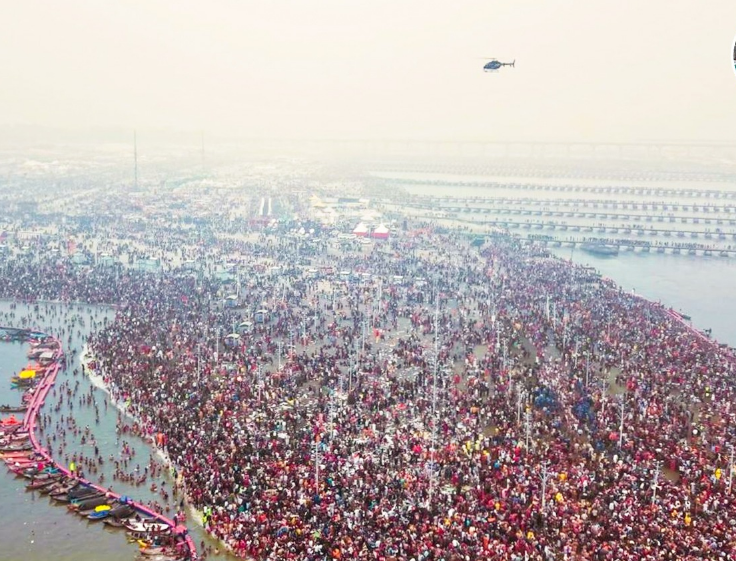The Maha Kumbh Mela, currently underway in Prayagraj, India, stands as a testament to the enduring spiritual traditions of Hinduism. This grand festival, which commenced January 13 and will conclude February 26, is anticipated to attract approximately 400 million devotees from around the globe.
Religious significance
The Kumbh Mela holds profound importance in Hinduism, symbolising the victory of gods over demons in the quest for the elixir of immortality. According to Hindu mythology, during a cosmic battle, drops of this sacred nectar fell at four earthly locations: Prayagraj, Haridwar, Ujjain, and Nashik. These sites have since become the rotational venues for the Kumbh Mela, where pilgrims gather to bathe in sacred rivers, seeking purification of the soul and liberation from the cycle of rebirth.
Types of Kumbh Melas
There are four primary types of Kumbh Melas, each varying in frequency and significance:
Kumbh Mela: Held every three years, rotating among the four sacred locations.
Ardh Kumbh Mela: Takes place every six years, specifically in Haridwar and Prayagraj.
Purna Kumbh Mela: Takes place every twelve years at any of the four sites.
Maha Kumbh Mela: The most auspicious, occurring once every 144 years, exclusively in Prayagraj.
Read Also: Steve Jobs’ wife Laurene Powell prays at UP temple, to visit Maha Kumbh
Important dates
The 2025 Maha Kumbh Mela features several significant bathing dates, known as ‘Shahi Snan’ or royal baths, which are considered highly auspicious:
January 14, 2025: Makar Sankranti
January 29, 2025: Mauni Amavasya
February 3, 2025: Basant Panchami
February 12, 2025: Maghi Purnima
February 26, 2025: Maha Shivaratri
On these dates, millions of pilgrims immerse themselves in the confluence of the Ganges, Yamuna, and the mythical Saraswati rivers at the Triveni Sangam in Prayagraj, believing that such acts cleanse them of sins and aid in attaining Moksha.
Logistics and infrastructure
To accommodate the vast influx of pilgrims, authorities have established a sprawling temporary city over 4,000 hectares. This includes the installation of approximately 150,000 tents and an equal number of toilets to ensure adequate lodging and sanitation. Security measures are robust, with around 50,000 personnel deployed to maintain order and safety. The estimated budget for the event is approximately $800 million, with projections indicating an economic boost of $30 billion to $35 billion for the region.
Read Also: 40 crore pilgrims expected to attend 2025 Maha Kumbh
Global significance
Recognised as the world’s largest peaceful gathering, the Maha Kumbh Mela has garnered international attention. Dignitaries and visitors from various countries, including the United States, Israel, and France, are expected to attend, underscoring the festival’s universal appeal and the rich cultural heritage it represents.
In essence, the Maha Kumbh Mela 2025 is not merely a religious congregation but a vibrant celebration of faith, tradition, and humanity’s collective pursuit of spiritual enlightenment.
Role of Akharas in Kumbh Mela
Akharas are an integral part of the Kumbh Mela, serving as centres of spiritual learning and guardians of Hindu traditions. Originating in the 8th century, these monastic organisations were established by Adi Shankaracharya to unify various sects of Hinduism and safeguard its philosophical tenets. Today, they play a pivotal role in the Mela, especially during the Shahi Snan or royal baths.
Read Also: Mandatory quarantine for Kumbh pilgrims
The Akharas are divided into three primary categories: Shaiva Akharas, dedicated to Lord Shiva; Vaishnav Akharas, devoted to Lord Vishnu; and Udasin Akharas, which focus on ascetic practices and philosophical teachings.
During the Kumbh Mela, the procession of Akharas to the bathing ghats is a spectacular event. Clad in saffron robes or smeared with ash, the sadhus and ascetics display a range of spiritual fervour, from meditation to martial arts. The Akharas are instrumental in preserving the cultural and spiritual ethos of the Mela, attracting millions of devotees to their discourses and rituals.
Guinness book of records in Kumbh Mela 2019
The Kumbh Mela 2019 in Prayagraj made its mark in the Guinness Book of Records, earning accolades for several extraordinary achievements. Recognised as the world’s largest religious gathering, the event drew over 240 million pilgrims over its 49-day span. The sheer scale and organisation of the event highlighted India’s logistical prowess and cultural vibrancy.
Read Also: UP cabinet holds meeting at Kumbh, ministers take dip in Sangam
Three specific records were set during this Mela:
Largest traffic and crowd management exercise: The festival showcased impeccable crowd control, managing millions of devotees seamlessly across an area of 3,200 hectares.
Largest sanitation drive: Over 10,000 sanitation workers ensured cleanliness throughout the event, making it a benchmark for hygiene at mass gatherings.
Biggest painting exercise of public places: Approximately 20 million square feet of walls were adorned with vibrant murals, showcasing themes of Indian culture, mythology, and social awareness.
The inclusion of these records underlined the global significance of the Kumbh Mela, elevating it as a symbol of faith and meticulous planning. It also demonstrated how traditional spiritual events can achieve modern benchmarks of sustainability and infrastructure.
PNN
